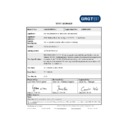JBL AUTHENTICS L8 (serv.man2) EMC - CB Certificate ▷ View online
Report No.: EM201300650-1 Application No.: ZJ00032008 Page 21 of 42
802.11b mode:
Measurement Conditions:25°C
Channel 2412MHz
Channel 2472MHz
Report No.: EM201300650-1 Application No.: ZJ00032008 Page 22 of 42
802.11g mode:
Measurement Conditions
Frequency spot with level
≤ -30dBm/100KHz
Limit
(MHz)
Temperature
(°C)
(°C)
Voltage
(V
(V
AC
)
FL FH Lower
Higher
+25
Vnom 2401.100
2482.600
FL>2400.0 FH< 2483.5
0
Vmin 2401.110
2482.570
Vmax 2401.130
2482.580
+70
Vmin 2401.120
2482.590
Vmax 2401.110
2482.580
FL: Lowest frequency of the power envelope, it is the frequency furthest below the frequency of
maximum power where the output power drops below the level of –80 dBm/Hz spectral power
density (-30 dBm if measured in a 100 kHz bandwidth) e.i.r.p..
FH: Highest frequency of the power envelope, it is the frequency furthest above the frequency of
maximum power where the output power drops below the level of –80 dBm/Hz spectral power
density (-30 dBm if measured in a 100 kHz bandwidth) e.i.r.p..
Vnom =AC230V/50Hz;Vmin = AC207V/50Hz; Vmax= AC253V/50Hz
maximum power where the output power drops below the level of –80 dBm/Hz spectral power
density (-30 dBm if measured in a 100 kHz bandwidth) e.i.r.p..
FH: Highest frequency of the power envelope, it is the frequency furthest above the frequency of
maximum power where the output power drops below the level of –80 dBm/Hz spectral power
density (-30 dBm if measured in a 100 kHz bandwidth) e.i.r.p..
Vnom =AC230V/50Hz;Vmin = AC207V/50Hz; Vmax= AC253V/50Hz
TEST RESULTS: The EUT compliant the requirements.
Report No.: EM201300650-1 Application No.: ZJ00032008 Page 23 of 42
802.11g mode:
Measurement Conditions:25°C
Channel 2412MHz
Channel 2472MHz
Report No.: EM201300650-1 Application No.: ZJ00032008 Page 24 of 42
4.4 MEDIUM ACCESS PROTOCOL
4.4.1 LIMITS
A medium access protocol shall be implemented by the equipment.
4.4.2 REQUIREMENT
On the basis of the latest list of harmonized standards under the R&TTE Directive 1999/5/EC which
was published on October 23, 2012 in Official Journal C321 contains the following (mandatory)
guidance: The efficiency of the various sharing mechanisms can be assessed using the
appropriate clauses of EN 300328 version 1.8.1.
Adaptive equipment using modulations other than FHSS shall implement either of the Detect and
Avoid mechanisms provided in clauses 4.3.2.5.1 or 4.3.2.5.2.
4.4.3 MODULATION SPECIFICATION
This transmitter device is wide band modulations device, and complies with EN 300 328 4.3.5
standard. This device uses 802.11 protocol which operates in 2400~2483.5MHz band. 802.11b uses a
radio technology called Direct Sequence Spread Spectrum (DSSS). DSSS transmissions multiply the
data being transmitted by a "noise" signal. This noise signal is a pseudorandom sequence
of 1 and −1 values, at a frequency much higher than that of the original signal. The resulting signal
resembles white noise, like an audio recording of "static". However, this noise-like signal can be used
to exactly reconstruct the original data at the receiving end, by multiplying it by the same
pseudorandom sequence.
802.11b uses a radio technology called orthogonal frequency-division multiplexing (OFDM).
OFDM
is a specialized FDM, the additional constraint is all the carrier signals are orthogonal to each other. In
OFDM, the sub-carrier frequencies are chosen so that the sub-carriers are orthogonal to each other,
meaning that cross-talk between the sub-channels is eliminated and inter-carrier guard bands are not
required. This greatly simplifies the design of both the transmitter and the receiver; unlike
conventional FDM, a separate filter for each sub-channel is not required.
Click on the first or last page to see other AUTHENTICS L8 (serv.man2) service manuals if exist.

